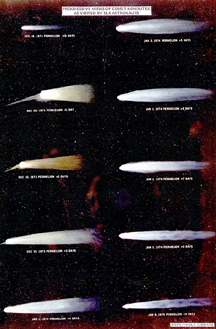Today scientists are still very interested in studying comets. This montage is an artist’s conception of progressive views of the Comet Kohoutek based on sketches and a description by Skylab-4 astronaut Edward Gibson. An early discovery of a large comet in an orbit that would reach close to the Sun at the end of 1973 prompted NASA to initiate Operation Kohoutek, a program to coordinate widespread observations of the comet from ground observatories, aircraft, balloons, rockets, unmanned satellites, and Skylab.
Click on image for full size
NASA
Comets Throughout History
"Threatening the world with Famine, Plague and War: To Princes, Death! To Kingdoms, many Crosses; To all Estates, inevitable Losses! To Herdsmen, Rot; to Plowmen, hapless Seasons; To Sailors, Storms, To Cities, Civil Treasons!"
De cometis by John Gadbury, London, 1665
Civilizations throughout recorded history have been fascinated with
comets, and have held them in awe, fear, and wonder. The earliest
references to comets refer to them as "terrible balls of fire" that sowed
terror. As the centuries passed, people began to see comets less as
potentially destructive objects and more as omens of either good or bad
things that would soon happen. For instance, Augustus Caesar became
emperor of Rome around the same time a comet appeared in the sky, and this
was widely held as a sign that his reign would be blessed by the gods.
Even though comets were long thought to have supernatural roles,
scientists and philosophers tried to understand what comets were and where
they came from. The Greek philosopher Aristotle thought that comets were
merely meteors, while the much later French thinking Descartes thought they
were messengers from other worlds. Still another philosopher,
Georges-Louis Buffon, thought that comets were the source of the Sun's
energy, and that they had actually set the planets in their orbits around
the Sun. Gradually, though, scientists began to see that comets appear and
disappear with regular cycles, and that they are actually small balls of
ice and dust trailed by a tail of gas and dust.
You might also be interested in:

For thousands of years, the Egyptian civilization used a written language called hieroglyphics. This language was used from ancient times through the last several centuries B.C. At this point, the Greeks
...more
"The movements of the heavenly bodies are an admirable thing, well known and manifest to all peoples. There are no people, no matter how barbaric and primitive, that do not raise up their eyes, take note,
...more
Hale-Bopp continues to offer new surprises as two astronomers report of their study of the comet. Using the Hubble Space Telescope and the International Ultraviolet Explorer, the astronomers did a year-long
...more
Six spacecraft flew by Halley's comet in 1986. There were two spacecraft launched from Japan, Suisei and Sakigake, and two from the Soviet Union, Vega 1 & 2. One spacecraft, ICE, from the United States
...more
Comets are observed to go around the sun in a long period of time or a short period of time. Thus they are named "long-period" or "short-period" comets. One group of short-period comets, called the Jupiter
...more
Scientists have learned a great deal from the crash of comet Shoemaker-Levy 9. Scientists traced the orbit of the comet backwards in time to guess its origin. The crash of a comet like Shoemaker-Levy 9
...more
Mathematical theory suggests that comet Shoemaker-Levy 9 was likely a short-period comet which was captured into orbit around Jupiter in 1929 and began to execute the path plotted in this diagram. This
...more















